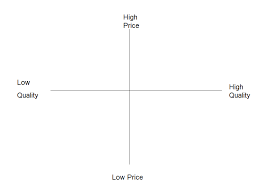Whether a business is well-established or in its infancy, its most important asset is its competitive advantage.
Its competitive advantage is the strategic issue, or the factor that provides it with an edge over its rivals. Studying the competition is the only way to establish, comprehend, and protect a competitive advantage.
Who is competing with the corporation for the time and money of its customers?
Do they sell products that are competitive or potential substitutes?
What are their advantages and disadvantages?
How do they fare in the marketplace?
Ray Kroc, the American entrepreneur responsible for the success of the fast-food chain McDonald's, purportedly did this by inspecting competitors' trash. However, a variety of more conventional instruments exist to assist businesses in comprehending themselves, their markets, and their competition.

SWOT - Competitive Advantage The most prevalent of these tools is the SWOT analysis. It was developed by US management consultant Albert Humphrey to identify internal strengths (S) and weaknesses (W) as well as external opportunities (O) and threats (T). Internal factors that can be considered either strengths or disadvantages include management's experience and expertise, the skill of the workforce, the quality of the product, the company's financial health, and the brand's strength. External factors that may represent opportunities or threats include market growth, new technologies, market entry barriers, the potential for international sales, and changing consumer demographics and preferences.
SWOT analysis is a staple in business management courses and is utilized by businesses of all varieties. It is a creative instrument that enables managers to assess the current standing of a company and to envision possible future standings.
A SWOT analysis should inform strategic planning and decision-making when conducted effectively. It enables a business to determine what it does better than competitors (or vice versa), what adjustments it may need to make to minimize threats, and what opportunities may give it a competitive advantage. The key to strategic fit is ensuring that the internal and external environments of a company are compatible: its internal strengths must be aligned with external opportunities. Any internal flaws should be addressed in order to mitigate the external threat.
When conducting a SWOT analysis, it is possible to include the opinions of staff and even customers; it should provide an opportunity to solicit opinions from all stakeholders.
The greater the number of perspectives included, the greater the depth of the analysis and the utility of the findings.
Nevertheless, there are constraints.
A company may be able to accurately assess its internal vulnerabilities and strengths, but projections regarding future events and trends (which will impact opportunities and threats) are always subject to error. Different stakeholders will have access to varying levels of information regarding a company's activities and, consequently, its current standing. Balance is essential; senior managers may have a comprehensive view of the company, but their perspective must be enlightened by alternative perspectives from all organizational levels.
As with all business tools, the effectiveness of a SWOT analysis is determined by whether or not it results in action. Even the most exhaustive analysis is ineffective if its findings are not translated into well-conceived plans, new procedures, and enhanced performance.
Market mapping
Market mapping (also known as "perceptual mapping") is a slightly more specialized but more sophisticated instrument for analyzing a business's position and competition. Market maps are diagrams that depict a market and the placement of products within that market, allowing for a visual examination of the competition.
The process is useful both internally (to help a company comprehend its own products) and externally (to chart how consumers perceive the brand relative to the competition).
In order to create a market map, a business identifies several consumer purchase-decision factors that compete with one another.
In the fashion market, "technology" versus "fashion" and "performance" versus "leisure" are examples of competing terms. Additional factors may include the item's price (high vs. low), its production quality (high vs. low), its style (fashionable vs. conservative), or its durability (versus its disposability). Then, two of these dimensions, or pairs of opposites, are plotted on a horizontal or vertical axis.
All the products within a particular market can be plotted on the map based on market research or the knowledge of managers. The market share of each product can be represented by the scale of its corresponding image on the map, but analysts typically prefer to make a rough sketch of the market without regard to market share.
A company may choose to construct multiple market maps, each of which depicts a unique set of variables, and then analyze them individually and collectively to gain a comprehensive understanding of its market position.
Finding the niche
The objective of market mapping is to identify opportunities for competitive differentiation. These are the areas in which the company offers distinctive value, and they can be used to inform marketing communications. The map will also disclose densely populated areas, which indicate an increased competitive threat.
A market map can be used to identify a viable gap in the market, which is a good location to position a company that is struggling to gain traction.
Using market mapping and SWOT analysis, established businesses can identify opportunities and determine whether they have the resources to capitalize on one of them.
The market map serves to inform the strategy (the need to reposition a product in a manner relative to competitors' offerings, for example) and tactics (moving from conservative to sporty, for example) that will assist the company in achieving its strategic objective.

SWOT - Competitive Advantage
Internal emphasis
As a business expands, it may decide to create a map of its own products. Analysis of the results can help identify any overlap between different products (informing decisions about which products to discontinue and on which to concentrate R&D and marketing expenditures, for instance). It can also be used to ensure the consistency of the company's marketing message, thereby preventing strategic drift.
Market research is essential to a successful market planning strategy. Although it can be beneficial to compare internal and external perceptions of a product, as well as the products of the competition, what matters most are the opinions of the customers. Even if managers disagree, the market map cannot be "wrong" when based on such information; it simply represents how the brand is perceived, for better or worse. The challenge for management is to use the map and knowledge of the organization's internal assets and weaknesses to plan the most suitable strategic response.
SWOT analysis and market mapping enable a business to better comprehend itself, its market, and, most importantly, its competition.
Similarly, understanding your weaknesses can help you avoid costly strategic errors, such as producing excessively ambitious products or entering a competitive market position. Long-term strategic planning requires a thorough understanding of the market's opportunities and threats, as well as the relative and ever-changing positions of competing products. To plan where you are headed, it is helpful to know where you currently stand and where your competitors stand as well.
Comentarios